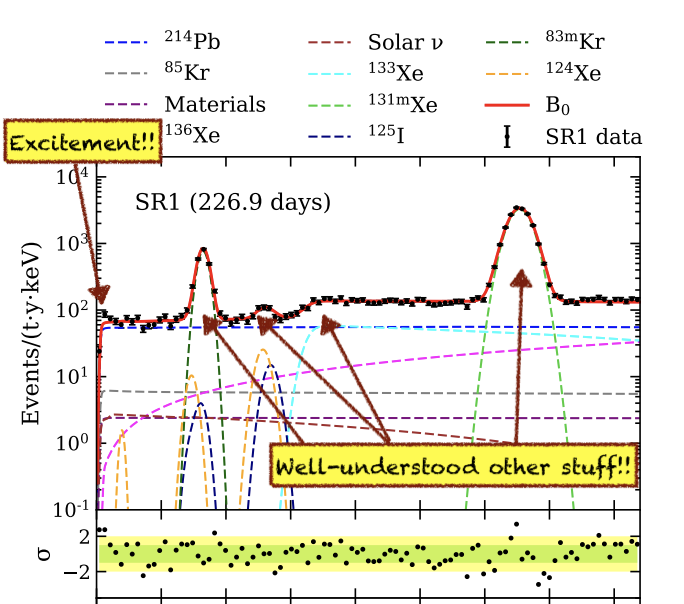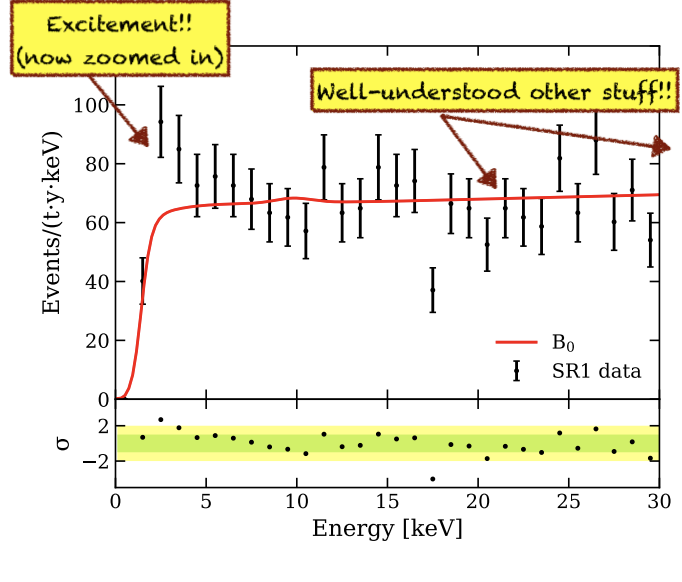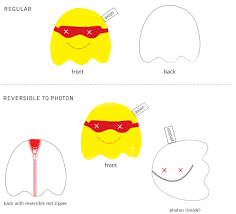So, the Twittersphere has been buzzing with #axions, #darkmatter, #tritium (or not) and the general excitement coming from the @XENONexperiment. That is totally deserved, and in the thread below I explain why. If you want to read the paper itself: https://arxiv.org/abs/2006.09721 ">https://arxiv.org/abs/2006....
First things first: what is the Xenon experiment? it is an experiment in Italy using a big tank of extremely pure liquid Xenon, about 3 tonnes of it (the experiment is humbly called Xenon-1tonne). It& #39;s under a big mountain in a lab in a tunnel. Google how to get there, it& #39;s cool.
Now why Xenon? Because when particles that normally do not interact hit a Xenon atom, there is a minute chance that the Xenon atom emits a minute bit of light. And importantly because most other atoms do that much more, and for Xenon that light is very well understood.
So obviously all that liquid Xenon is inside a big tank and comes with all sorts of fancy electronics to see that light. Here you see a picture of the experimental tank where @XENONexperiment colleagues helpfully put up a picture of what is inside the tank
So you have a fancy tank of inert liquid Xenon that emits light when something hits it. The amount of light depends on how hard the atom is hit. So now the goal is to see when something interesting hits one atom! The experiment examined this fresh batch of data collected in 17-18
Yes, so that is data from 2017-18 because analysing data in an unbiased way takes time! It& #39;s not easy, and many things need to be checked. In the end, and after a lot of work I& #39;m sure, the kinetic energy of what hit the atom can be measured beautifully
So here you see the measured energy of light from the Xenon collisions. I have annotated the Xenon1T plot from the paper a bit to show where most (understood) collisions are and what the excitement (!!) is about
Now the Xenon colleagues have conveniently already zoomed in, as the excitement is really at low energies. Here is the zoomed-in plot. With the excitement (!!)
So it& #39;s obvious that there are more events (black points, yes with error bars because it is science peeps!) at low values than are expected (red line). An obvious question is "is that red line correct?" So to check that, all known effects were also simulated to make the same plot
Conclusion: the red line is realistic, and whatever is creating these extra events is not something that was anticipated.
By the way, you can see the events are randomly distributed. The chance that the exciting events are just random is more than 1 in about 1000 (3.5 sigma)
By the way, you can see the events are randomly distributed. The chance that the exciting events are just random is more than 1 in about 1000 (3.5 sigma)
There are 53 too many ( the background is 232 ± 15 events, the observed number is 285 light flashes coming off Xenon atoms). So - what are these extra events?
This is where things get more speculative. The Xenon peeps already looked at three scenarios but I expect many more explanations soon!
They could be a special kind of Dark Matter called axions. Or a proof neutrinos behave differently than we know. Or background from Tritium
They could be a special kind of Dark Matter called axions. Or a proof neutrinos behave differently than we know. Or background from Tritium
Which of those is it? Or maybe the experiment was just this one in thousand chance of a fluke? Only time will tell.
Fortunately, Xenon will take a lot more data in the future. And a similar experiment called Lux-Zeppelin (LZ, @lzdarkmatter will turn on soon)
Fortunately, Xenon will take a lot more data in the future. And a similar experiment called Lux-Zeppelin (LZ, @lzdarkmatter will turn on soon)
So let& #39;s now focus on each of those explanations. Let& #39;s start with the boring one: of course, that tank of Xenon does not only contain Xenon. If the amount of Tritium (Hydrogen atoms with two extra neutrons) is unexpectedly much larger than expected, it could create this excess!
More exciting, would be if the extra events are due to neutrinos, the ghost particles that are all around us, behaving slightly differently when they pass/hit a Xenon atom. The extra events could only be consistent with neutrinos that magnetically behave differently than expected
To be specific, the extra events could be consistent with neutrinos hitting Xenon if they have an enhanced neutrino magnetic moment (interaction with a magnetic field), which can only be the case if those neutrinos are not consistent with the picture of the standard model.
Arguably even more exciting is the next explanation: the extra events could be consistent with a hypothetical dark matter particle called Axion, with really odd properties that are associated with magnetism, magnetic monopoles and the matter/antimatter asymmetry in the universe.
Axions don& #39;t really interact (much) with other particles and were originally predicted by Roberto Peccei and Helen Quinn to solve the fact that quarks, antiquarks and gluons need to behave identically under a physics assumption called Charge-Parity conservation
Unsurprisingly, the axions are out of stock at http://particlezoo.net"> http://particlezoo.net (I just checked), but Peccei&Quinn& #39;s theory predicts that they can switch from being visible to invisible depending on what is happening around them magnet-wise

 Read on Twitter
Read on Twitter







